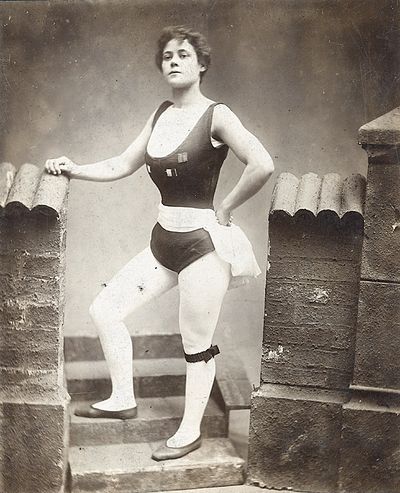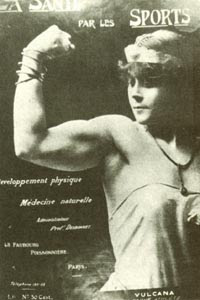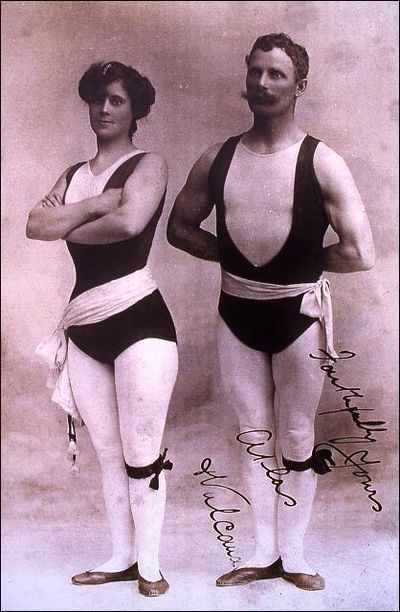Vulcana: Difference between revisions
(Created page with "{{Header|Vulcana 04/24}} == Vulcana - The Victorian Wonder Woman == 400px|center|{{bc|Vulcana (pic via Creative Commons)}} In the 21st Century, female bodybuilders and weightlifters are commonplace, but back in 19th Century Britain, these female athletes were unique and unusual. People flocked to music halls and theatres to witness their jaw-dropping feats of strength. Bu there was one wonder woman who stood out amongst them all - Kate Williams...") |
(No difference)
|
Latest revision as of 06:17, 24 April 2024
Vulcana - The Victorian Wonder Woman
In the 21st Century, female bodybuilders and weightlifters are commonplace, but back in 19th Century Britain, these female athletes were unique and unusual. People flocked to music halls and theatres to witness their jaw-dropping feats of strength. Bu there was one wonder woman who stood out amongst them all - Kate Williams aka Vulcana.
Born Miriam Katherine Williams on the 6th of May 1874 in Abergavenny, Monmouthshire, Kate’s physical aptitude was evident from a young age and was fortunately encouraged by her father, a local Baptist preacher.
In 1890 she met her future partner William Hedley Roberts at a local women’s gymnasium that he ran. The same year Kate appeared with a troupe of athletes at a fete in Pontypool. She stepped in last minute to deputise for someone who had fallen ill, and was well received by the audience. William later stated this was the moment Kate decided to become a professional athlete and weightlifter.
Soon after starting out on this path, Kate decided to run away with the then-married Roberts – who was 11 years older than her - and his troupe to London. The pair began to be billed together as Atlas and Vulcana from the time of their first appearances in London in 1892. Their type of stage act was all the rage in music halls and theatres. Billed as brother and sister, although they were living as man and wife, they performed awe-inspiring feats of strength and agility. When joined by their troupe they were called The Atlas and Vulcana Group of Society Athletes.
Vulcana’s best-authenticated feats included a bent press with her right hand of at least 56.5 kg; a press of 66 kg; and an overhead lift with a 25 kg weight in each hand. A 1902 newspaper article stated “she can raise and hold above her head at arm's length a man weighing ever 12 stone." She was also hailed as the first women to take on the Tomb of Hercules stunt. This involved supporting a platform on her abdomen while leaning backwards on the floor while two horses and their attendants climbed onto the board.
Historians specialising in the history of weightlifting and bodybuilding believe Vulcana reached the peak of her strength in about 1910. On 29 May 1913 at Haggar's Theatre in Llanelli, she lifted a challenge bell that rival strongwoman Athelda failed to raise after twenty-five minutes of trying.
Atlas claimed numerous other records for Vulcana. However, these were not substantiated and it appears that Atlas greatly exaggerated both his own and Vulcana's achievements. As a result, Vulcana's reputation suffered alongside his. Her authenticated accomplishments were genuinely remarkable for a woman of her era, but were overshadowed by the egoistic claims made by her partner – all for the sake of showmanship.
Vulcana was not just a weightlifter – she was an all-round athlete who also swam, wrestled and fenced. She was used as an example to promote fitness for women at the time when physical culture was only just starting to become a concept. She even featured in one of the earliest ever physical culture magazines, established by the world famous professional strongman Eugene Sandow. A contemporary newspaper called Vulcana “the strongest lady living, who has created the new world's record in France and Spain, and founder of the modern school of physical culture for women, you will say you have seen the acme of physical culture."
As Atlas and Vulcana’s fame grew they reportedly performed in every music hall of note in Britain and Ireland. They also begin to travel abroad, visiting France, Holland and Spain. France loved Kate, and she charmed and impressed the l’Halterophile Club de France with a record-breaking weights session, and in Holland she was awarded a weight-lifting medal by the Queen of the Netherlands.
Atlas and Vulcana were gradually joined in their act by their six offspring, and they continued to perform until the 1930s, officially retiring in 1932. Vulcana eventually passed away on the 8th of August 1946 in London, just months after she had been hit by a cab in the street – even an accident that would have shuffled many a 72-year old off their mortal coil could not stop the mighty Vulcana.
External links
Chat rooms • What links here • Copyright info • Contact information • Category:Root


